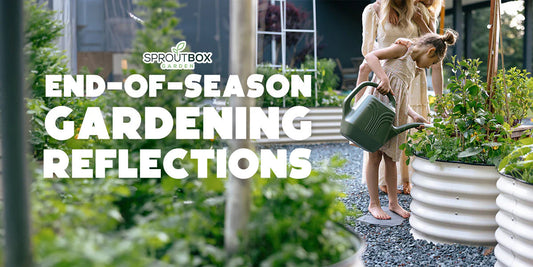The Basics of Raised Bed Gardening: Everything You Need to Know

Are you ready to start growing your own fresh produce in a beautiful, productive, and manageable space… and save a ton of money along the way?
Raised bed gardening is the best way to grow a variety of plants and vegetables in any outdoor area. In this post, we'll be diving into the basics of raised bed gardening, including the benefits, materials you'll need, and how to get started.
The NUMBER ONE Reason to Use Raised Garden Beds
It all comes down to one factor: control. With Raised garden beds, you can keep better control of your plants and the food you grow. Better control over soil quality, improved drainage, and easier access for gardeners of all ages and abilities.
These elevated gardens also allow you to grow a variety of plants and vegetables in a defined outdoor area, making them a great option for those with limited space.
Do the 'Pros' Outweigh the 'Cons'?
The cost of building a raised garden bed can vary, but the benefits definitely outweigh the expenses. Investing in a raised bed now will save you money and time in the long run. You'll be able to grow healthier and more productive plants, and you won't have to worry about spending time and energy on soil preparation and maintenance.
Not to mention, the right raised garden bed can last you up to 20 years! So the only time you'll have to worry about buying another one is to expand your garden.
That's why Sproutbox Garden metal raised beds are made out of food-safe Aluzinc Steel. Click here to learn more.
Planning Your Garden: What to Keep in Mind
So, the main benefit of using raised beds for gardening is that you have your own mini-environment for plants to grow healthy and happy. All the factors like moisture or type and quality of the soil are completely under your control.
BUT, when it comes to planning your garden, there is one extremely important thing that you'll need to consider: sunlight.
To have the best results, you must choose a location that receives at least six hours of sunlight per day. This is especially important for growing vegetables and herbs.
What's the Best Size and Height for Me?
The size and height of your raised garden bed will depend on the amount of space you have available and the type of plants you want to grow.
A general rule of thumb is to make your bed at least two feet wide and six feet long. This will give you plenty of space to plant your crops and work in the bed. As for height, it's recommended to make your bed at least six to eight inches high. This will allow for good drainage and easy access to your plants. However, raised beds can come in a variety of heights.
Taller garden beds will allow you to care for your plants more comfortably. At the end of the day, you may spend a full weekend morning out there. You'll want to make sure to look out for your back and knees!
Getting Your Garden Bed Ready for Planting
You'll want to make sure you research what soil and conditions are best for the specific vegetables you're growing.
When you're ready to go, remove any weeds, grass, or other debris from the area. Then, level the ground and add a weed barrier to prevent future weed growth. Then, fill the raised garden bed with a mixture of high-quality garden soil, compost, and other organic matter to create rich, fertile soil.
Make sure the soil is level and evenly distributed throughout the bed, and, if necessary, install an irrigation system to make watering your plants easier.
Plant your seeds in the raised garden bed following recommended planting guidelines, and space the plants properly to allow for adequate growth and sunlight.
Add a layer of mulch around the plants to help retain moisture and suppress weeds, and water the plants regularly, making sure the soil stays evenly moist but not waterlogged.
Finally, maintain the bed by adding compost and fertilizer as needed, and keep the bed weed-free by hand-weeding or using mulch. By following these steps, you'll have a thriving raised garden bed filled with a variety of delicious and beautiful plants in no time!
Why Metal is a Better Material than Wood
When it comes to building a raised garden bed, metal is often a better material than wood. Metal is durable, weather-resistant, and long-lasting, making it the perfect choice for raised garden beds.
Not only will wood have a shorter lifespan, as it decays it can attract unwanted life to your thriving garden. Unlike the typical Canadian gardener, ants, termites and other insects love the taste and look of rotting wood.
It's also available in a variety of sizes and shapes, so you can easily find a metal raised garden bed that fits your needs and space.
Take your Garden to the Next Level
Raised garden beds offer numerous benefits to gardeners, including improved soil health, better drainage, and reduced weed growth. By choosing a Sproutbox Garden raised bed, you can enjoy a long-lasting and durable gardening experience that will reduce not only your stress but also your grocery bills.
Whether you're a seasoned green thumb or a beginner just starting out, raised garden beds are a fantastic way to grow your own fresh produce, flowers, and herbs. Our beautiful, long-lasting, modular kits are easy to assemble and delivered to your front door, equipping you to make your world a healthier place.
Sprout with joy as you take control of what you eat, reducing stress and saving money.
Remember, happy gardening is all about soil, sun, and fun – and with a Sproutbox Garden raised bed, you'll have a garden that's above and beyond the rest!


